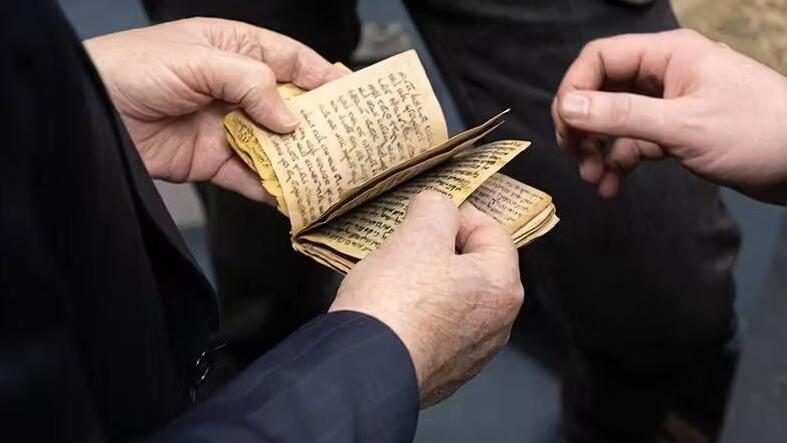Getting your Trinity Audio player ready...
The oldest Hebrew book – not a scroll – ever discovered went on display at an exhibition at the Museum of the Bible in Washington.
The Afghan Liturgical Quire, or as it is affectionately called by researchers, the ALQ, dates from the eighth century AD and is one of the few Hebrew manuscripts that survived the period, known as the "Quiet Period" (200 AD to 900 AD) from which very few Hebrew texts were preserved.
The book was discovered in Afghanistan in the Bamiyan Valley - an area that is considered a major junction on the Silk Road and is known mainly thanks to the giant Buddha statues along the way. Contrary to what is expected from a book found in such an area, it is not a Buddhist text, but a compilation of Shabbat prayers, liturgical poems and parts of the Passover Haggadah.
3 View gallery


The Afghan Liturgical Quire was discovered in Afghanistan
(Photo: Museum of the Bible)
Surprisingly, part of the title is written upside down, a rare phenomenon that adds interest to the extensive research that goes into the book. The writing in it even appears on both sides of the page, thus predating the liturgical customs established by Rabbi Amram Gaon in the 9th century by about 200 years.
The transition from a scroll to codex writings in the format of a book with pages following pages, similar to the book used today - represents a significant process in the history of Hebrew literature. While the scrolls were the traditional means of preserving the Jewish texts in antiquity, the book in question is one of the earliest evidences of the use of the codex - the more modern form of the book.
This form allowed the Jews to keep texts in a more convenient way for daily use, even when on the road, during an era in which Jews, like many others, were forced to migrate from place to place because of trade, persecutions and changes of government.
The Afghan book has survived for over 1,300 years in harsh conditions, but in its journeys over time – from the caves of the Bamyan Valley to the Museum of the Bible in Washington – it has managed to bridge cultures, countries and religions. It was discovered by local villagers as part of a collection found in fox caves in Afghanistan that served as a hideout from the Taliban for the Hazara ethnic minority, persecuted in Afghanistan over the years, who kept the holy book and protected it until it was smuggled out of the country in 2001.
Part of the collection, called the "Afghan Genizah" was purchased by the National Library in Israel in 2013, where it is kept. The ALQ was previously owned by an Israeli, and was bought from a private Israeli collector under the mistaken assumption that it was part of the Cairo Geniza. However, when the manuscript was donated to the Museum of the Bible in Washington in 2015, the researchers realized that it was an unusual and far more important discovery than they had first estimated.
The new exhibition was created as a collaboration between the Afghan Jewish community, Muslim representatives and Christian professionals. The curators of the exhibition are proud that this symbolizes the importance of the text - not only as a religious or historical object, but also as evidence of cross-border cooperation. "But it is fitting that a small book of prayers should start such a beautiful interfaith partnership," said the curator of the exhibition, researcher Herschel Hepler, who also described the discovery as "a game changer" in the study of Hebrew liturgy and ancient Hebrew writing.
3 View gallery


The Afghan Liturgical Quire dates from the eighth century AD a
(צילום: Museum of the Bible)
The Bible Museum presents the title as part of an exhibition called "Sacred Words: Revealing the Earliest Hebrew Book," which will continue until January 12. Along with the book, other rare Jewish items will also be on display, including fragments from the 9th century, a manuscript of the Haggadah from 1000 AD and the head of a Buddha statue from the 2nd century, which the king of Afghanistan gave to President John F. Kennedy in 1963.
The main goal of the exhibition is to explore the cultural processes that led to the ALQ's creation and to provide insights into the relationship between the Jewish people and other cultures that operated along the Silk Road, such as Buddhism and Islam. The curators of the exhibition emphasize that, beyond being a religious text, the ALQ tells a story of travel, trade and the survival of Jewish identity in areas where almost no living evidence remains.
The exhibition is already causing great excitement among the Afghan Jewish community, most of which fled the country to Israel in the 1960s. The community sees the discovery and preservation of the book as a kind of closing the circle, after many years of dispersion and persecution. Musa Lavoni, a former Afghan Jew who immigrated to New York, was excited to hear about the book finally being revealed to the public and told Ynet: "It excites me to see how something from our past, which has traveled such a long way, becomes accessible to the whole world."



